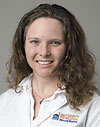 My first foray into clinical research was after my first year of medical school when I joined the research team of Dr. John Marshall in endocrinology. There, I learned about a clinical disorder called polycystic ovary syndrome, or PCOS, which I thought at the time was rare and only involved adult women. This syndrome occurs when women make too much male hormone (androgen) and have anovulatory menstrual cycles. The excess androgen can cause severe cosmetic problems of male-patterned hair growth (i.e., facial hair) and acne, while anovulation can lead to irregular, bothersome periods and infertility. That exposure to clinical research was one of several which formed my interest in endocrinology as a career.
My first foray into clinical research was after my first year of medical school when I joined the research team of Dr. John Marshall in endocrinology. There, I learned about a clinical disorder called polycystic ovary syndrome, or PCOS, which I thought at the time was rare and only involved adult women. This syndrome occurs when women make too much male hormone (androgen) and have anovulatory menstrual cycles. The excess androgen can cause severe cosmetic problems of male-patterned hair growth (i.e., facial hair) and acne, while anovulation can lead to irregular, bothersome periods and infertility. That exposure to clinical research was one of several which formed my interest in endocrinology as a career.
Since that time, I’ve developed a better appreciation for how common and problematic PCOS is for both girls and women. PCOS affects 6-8% of all reproductive-aged women—with increased prevalence (30%) in overweight women—which is ~105 million women between the ages of 15-49 years old worldwide. PCOS is also the leading single cause of female infertility and is associated with a host of metabolic problems including obesity, type 2 diabetes mellitus (DM), dyslipidemia, hypertension, cerebrovascular disease, cardiovascular disease markers, and possibly gestational DM and pre-eclampsia. Evaluation and treatment of PCOS and its co-morbidities have been estimated to cost ~ $4.37 billion in 2004 dollars annually, with ~40% due to the burden of increased prevalence of diabetes alone. We are just beginning to understand how excess androgen during puberty is a forerunner to adult PCOS.
Here at UVA, we’ve learned that 60-70% of girls with obesity already have elevated androgen levels, even before starting pubertal development. The focus of medical care for this disorder has been primarily treatment of adult women, as the precise mechanisms of early pathogenesis of this disorder are still unclear and therefore prevention is elusive. Understanding how excess androgen exposure during puberty—a time critical to developing one’s reproductive potential—contributes to the early etiologies of PCOS is essential for devising strategies/therapies for preventing the full-blown disorder.
Clinically, I care for hundreds of girls dealing with PCOS and/or androgen excess here at UVA. I now realize how much PCOS affects girls (not just adult women) in our local communities. I’ve also become very aware of the lack of information that we as a medical community have about how to treat girls during the very early stages of the disorder or how to prevent problems if we identify a girl at risk.
Therefore, I’ve reconnected with Dr. Marshall and his colleagues at the UVA Center for Research in Reproduction (CRR)—an NIH resource for hormone assay assessments—to investigate early pathophysiology of PCOS to try to discover ways to prevent and/or treat the disorder in girls. Specifically, I am funded by a K23 Patient-Oriented Research Career Development Award by the NIH Eunice Kennedy Shriver National Institute for Child Health and Human Development (NICHD) to study adrenal and ovarian sources of androgens in overweight girls throughout puberty and to try to diminish excess androgen responses with different potential therapies, including metformin and spironolactone. Additionally, I’m involved with ongoing studies at the CRR funded via the NIH NICHD Specialized Cooperative Centers Program in Reproduction and Infertility Research. These studies test how insulin resistance is related to androgen production and to gonadotropin (pituitary puberty hormone) regulation during puberty in overweight girls. We are identifying possible mechanisms via which obesity relates to androgen excess and to the development of PCOS in pubertal girls. In the process—as a somewhat unexpected but fulfilling bonus—we are also learning details about normal pubertal maturation in girls that have been previously unknown. (It’s still amazing to me that we don’t understand why things happen normally!)
A very fun part of my job has been to develop with Susan Cluett, CPNP, at the Children’s Fitness Clinic, and in collaboration with the CRR and Kohl’s, a fitness support program for girls called Go Girls! This has been a way for me to model the healthy behavior I advise during my clinics, to educate girls and their families about the dangers of inactivity and unhealthy eating behaviors, and to motivate girls to make real lifestyle changes. I became Zumba licensed to provide a fun and tailor-able form of exercise for the girls. I enjoy hearing the perspectives that the girls share during the program—it helps me to become a better clinician! Overall, the program has been very successful so far and we plan to expand the program throughout the Charlottesville and surrounding communities.
I love that my job allows me to provide care for girls struggling with PCOS in clinical and recreational settings, as well as engage in cutting-edge research that may lead to discoveries that eventually evolve into better care for my patients.
Filed Under: Spotlight
